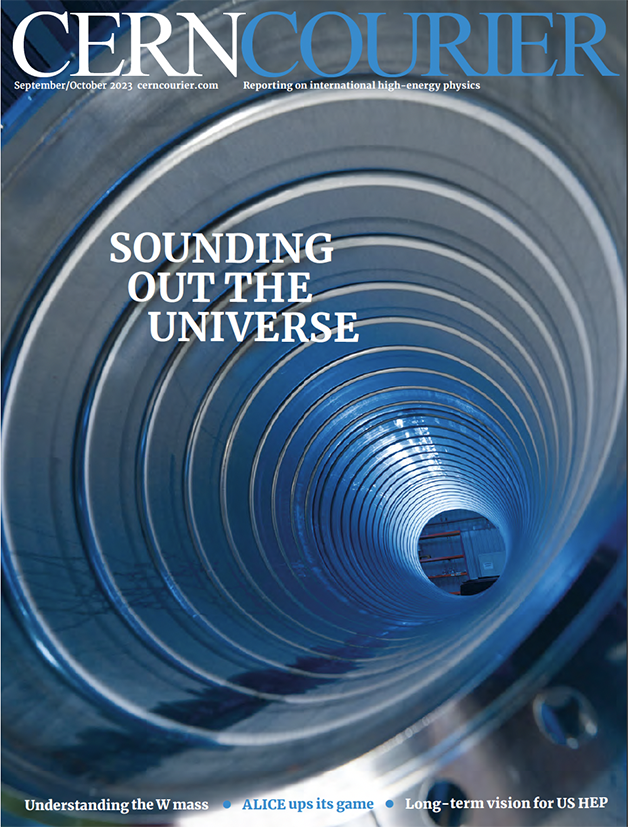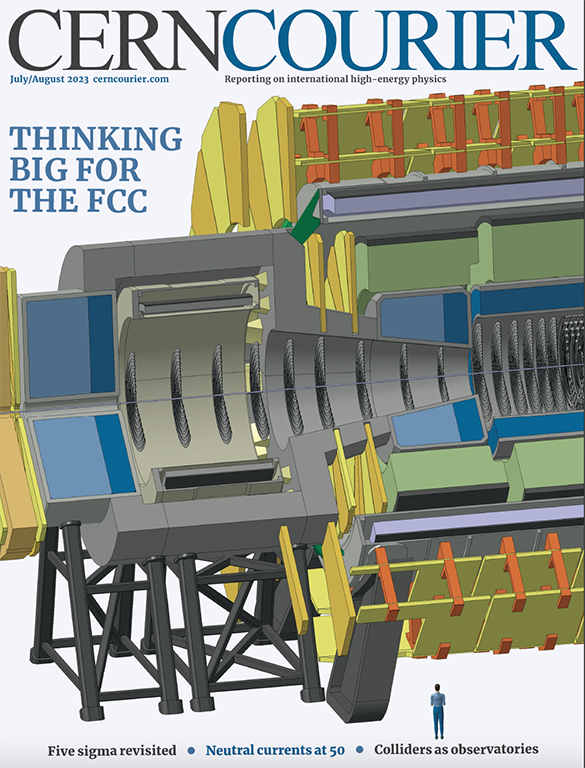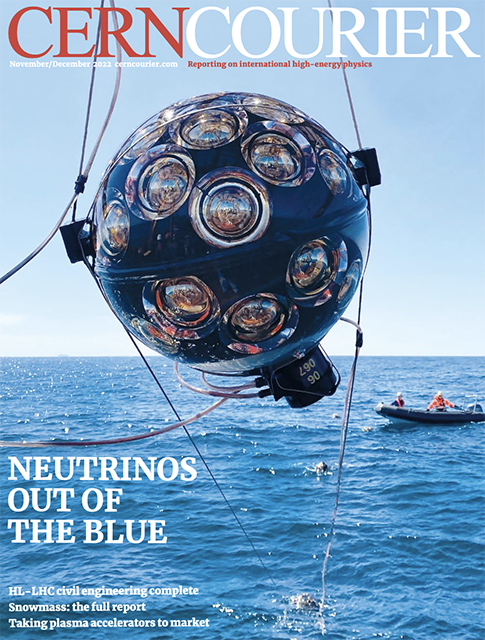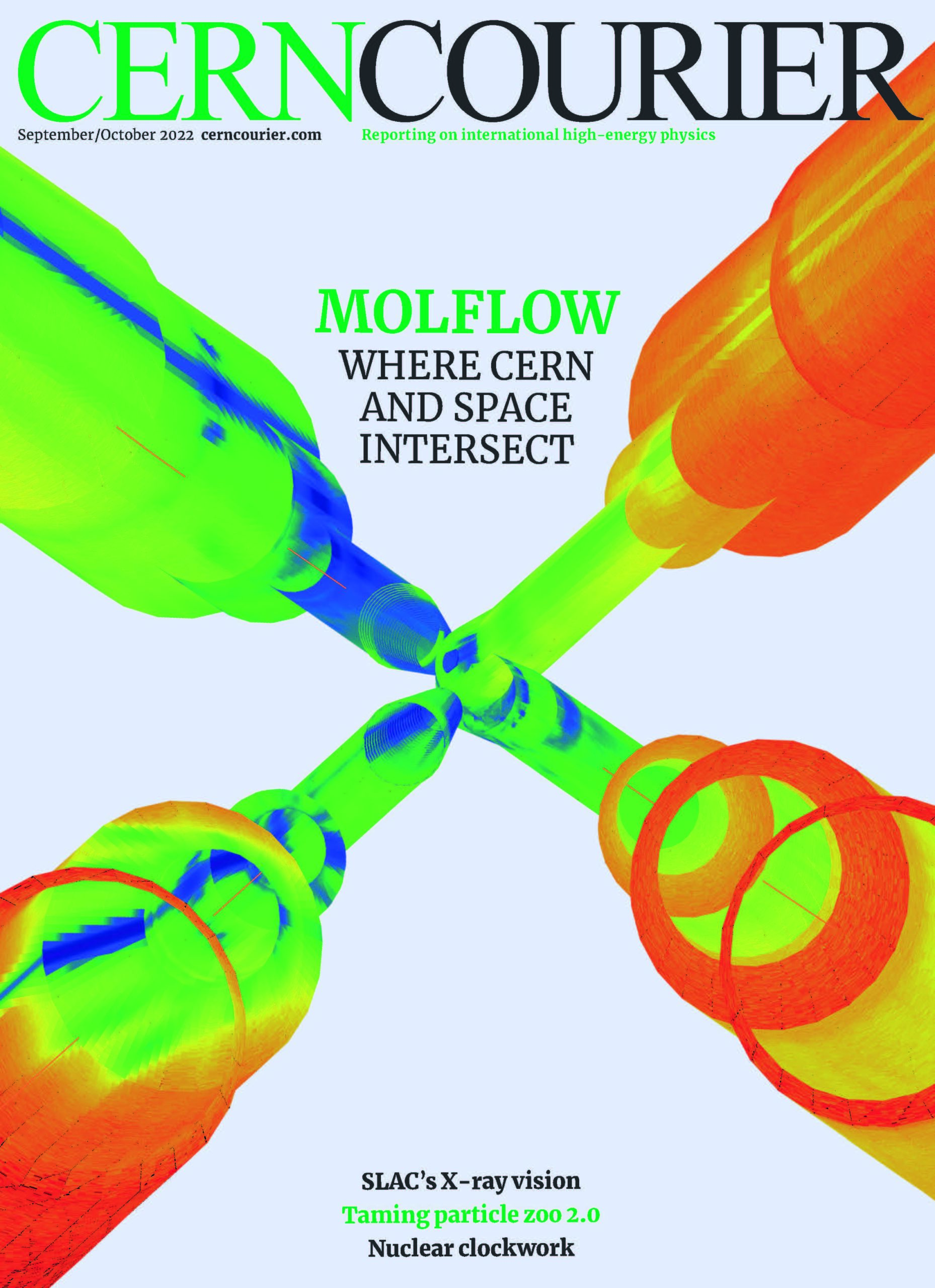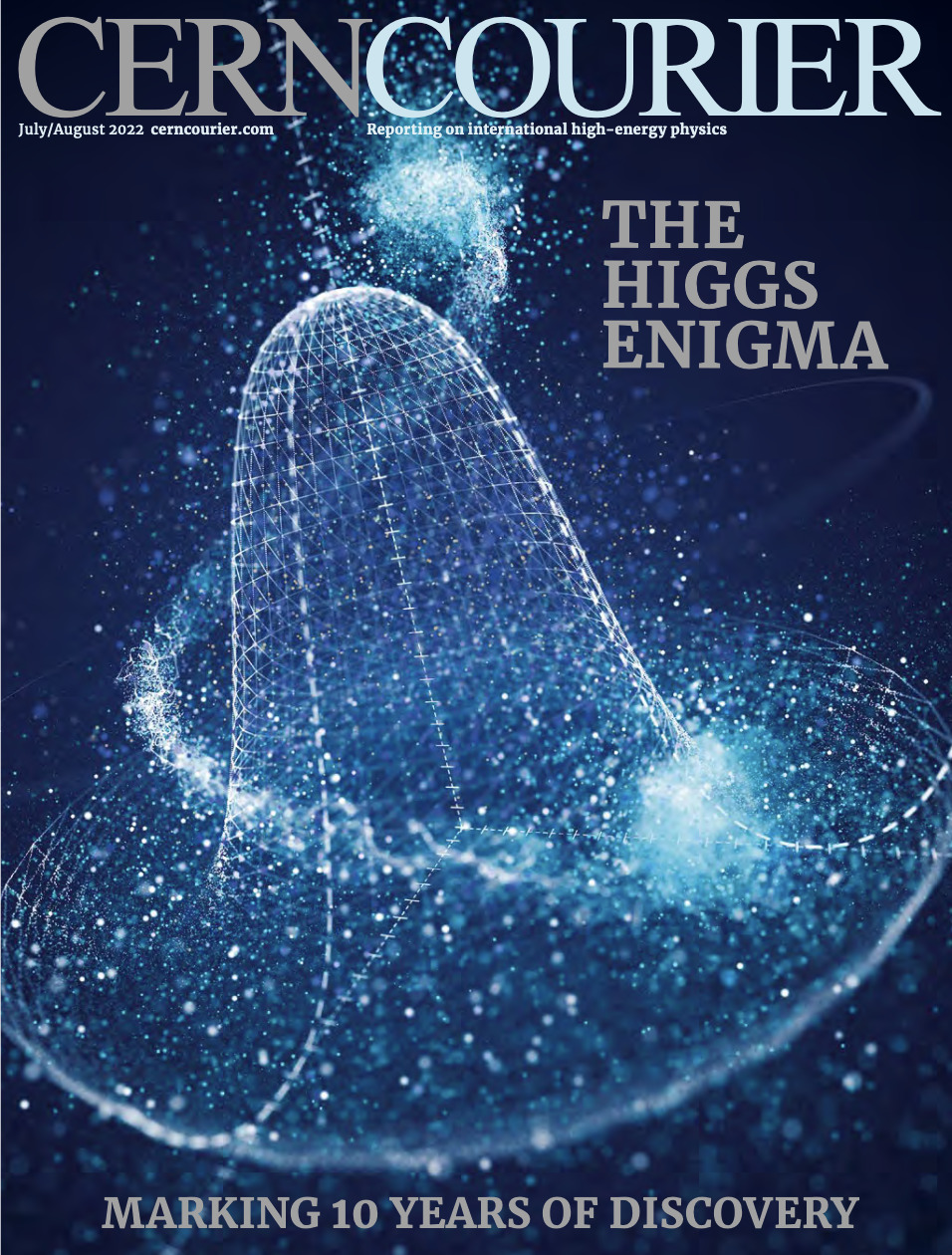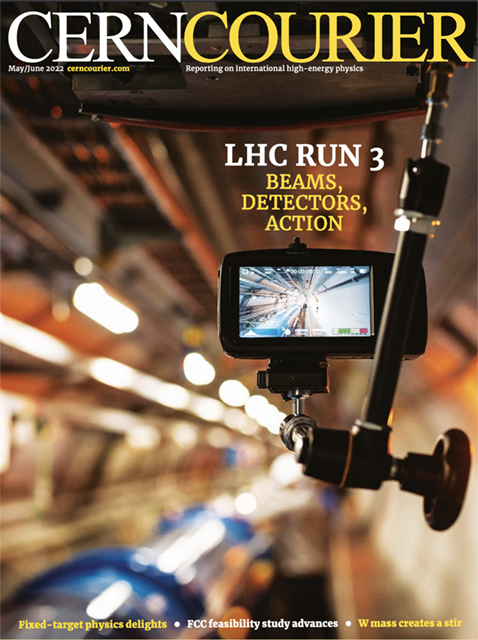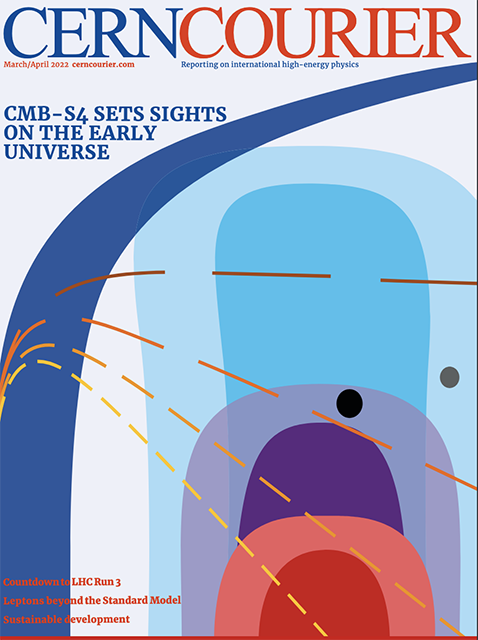CERN Courier issues
Here are the issues I worked on along with my personal highlights. If you’re interested, feel free to click on the link.
The latest issue
The overarching theme of this issue are the extreme discoveries of the last decade: the Higgs boson and gravitational waves. The universe sounds vividly when we listen to its heartbeat with gravitational waves and examine their many origins, which can be uncovered with pulsars turned into galactic detectors and with current and next-generation gravitational-wave detectors, such as the Einstein Telescope. A prototype of the vacuum beampipe is developed at CERN and adorns the cover.
Elsewhere at CERN, the GBAR experiment at CERN’s antiproton decelerator has joined the select club of experiments that have succeeded in synthesizing antihydrogen atom. In addition, two fundamental particles weigh in: the Higgs boson, whose mass we now know to a new precision and witness the W boson’s midlife crisis.
It is also nice to see that the LHC is very stable — it almost only fails when nature in form of falling trees or animals interrupts its run time. Before the advent of the HL-LHC, many experiments use already GPUs to accelerate the data selection and analyses, and the ALICE experiment took a pioneering role.
Moreover, we delve into a century of FCC physics, scrutinize the linear colliders concepts on offer, receive a broad overview over the vast landscape of accelerators and their use in physics and industry, witness Iraq joining SESAME, allow ourselves to be frogs among birds, collide with the world outside of particle physics, look forward at the LHC and harvest the latest LHC results and much more.
Read more here or click on the image.
Past issues
This time, the cover our July/August 2023 issue shows a detector simulation for the FCC. The feature about detector designs for the FCC which only one of our great summer reads in this issue. Besides the feature about the FCC study, we celebrate 50 years of neutral currents as well as event displays and scrutinise the 5σ discovery criterion.
The News Analysis section is filled with exciting results from CERN experiments, such as a nuclear clock based on the decay of thorium-229. The record precision on measuring CP-violating parameters extends LHCb’s flagship measurements and cements the experiment’s role as a major player together with experiments at lepton colliders. Even more interesting, LHCb is the only experiment that is powerful and precise enough to perform these searches at a hadron collider. Looking further at the LHC, ATLAS and CMS presented together the first evidence of the rare Higgs-boson decay into a Z boson and a photon. Outside CERN, researchers found that the puzzling proton radius has roughly three different regions.
If this is still not enough, there is a very nice review about a book dedicated to the memory of Jack Steinberger, who would have had his 100th birthday this year.
Read more here or click on the image.
The May/June 2023 issue’s cover shows a high-temperature superconductor, which is referred to as “Python” at CERN due to its shape. One of our feature articles is about this topic.
Physicswise, Moriond – the most important high-energy physics conference of the year – dominates as we covered many results: They appear in the News Digest and the Energy Frontiers sections, which I edited, and the News Analysis section, in which I wrote an article about the conclusion of the MAJORANA DEMONSTRATOR experiment.
An enjoyable read is the feature “Cosmic rays for Cultural heritage“, which describes the application of muon tomography -or muography – to for minimal invasive application, such as the scan o Khufu’s pyramid, and many other buildings. The edit and the work with the author was an incredible joy.
On 15 June, Cabibbo’s famous paper has its 60th anniversary – reason enough for Luciano Maiani, the “M” of the GIM-mechanism, Nobel laureate Girogio Parisi and Guido Martinelli to write about him. 50 years ago, Kobayashi and Maskawa extendend his work and created the famous CKM matrix, which describes the probability of quark-flavour transitions. An event celebrated this anniversary and it was also great to edit the meeting report.
Read more here or click on the image.
The March/April 2023 issue’s cover shows the ALICE experiment, the red giant star of the LHC experiments dominating the issue. The experiment shows up in three parts: In the News Analysis section, as a feature article about the ALICE 3 upgrade and in the Energy frontiers section. The News Analysis article refers to their “space mission”: ALICE experimentalists used the fact that their detector is one of the rare places in the world, which can produce anti-helium. They tested disappearance probabilities, which are vital in astrophysics sources.
LHCb complements the feature articles series about the LHC Phase-II upgrade.
My personal highlight was the interview with Lenny Susskind, a giant in theoretical physics and founder of string theory.
Read more here or click on the image.
The January/February 2023 issue marks the start of the LHC experiments’ Phase-II upgrade with ATLAS and CMS, which is on the cover.
One topic very close to my heart is an article written by me in the News Analysis section: “Radiotherapy debut for proton linac“. The article reports about the first proton linac, which reached its maximum energy of 230 MeV and will hopefully treat first patients in 2023. The whole section is about knowledge transfer.
The interviewee was Maryna Viazovska and I had the pleasure to also host the public talk she gave at the CERN Globe. It was amazing to meet and to ask her about her work and her understanding about maths in general.
The other topic close to my heart was the theory feature “A theory of theories“, which is about effective field theories. I worked with effective field theories at university and they fascinate me until today due to their versatility.
Read more here or click on the image.
The November/December 2022 issue reported about the end of ANTARES and the beginning of ORCA, the neutrino detectors in the Mediterranean sea.
It was a surprise, in which short amount of time the LHC experiments recorded first physics data – CMS took only three weeks to come up with enough data for a first physics result.
Read more here or click on the image.
The September/October 2022 issue’s main theme is connecting space space with CERN. With a programming software developed at CERN or via the interview with Stefano Vitale, co-principal investigator of the LISA project, which has a collaboration with CERN about vacuum technology.
It was also the issue, where we published Webb’s first images as well as the first event displays of the LHC Run 3 collisions, a feature about nuclear clocks, Herwig Schoppers’ plea for peace and much more.
For the first time, we published a meeting report by the IAEA, which I commissioned and edited. Besides, the FCC week is covered as well as IPAC.
Even more important – we interviewed the tiny creatures, which interviewed me in return. Read it on the background page.
Read more here or click on the image.
The July/August 2022 issue was about the Higgs-boson discovery at CERN 10 years ago.
Special features covered everything what is known about the Higgs boson and where the future might take us.
After the Hiss symposium on 4 July, the Courier went into a small summer break, and many readers told us that the issue was an enjoyable summer read.
It was the issue of my quirkiest News Digest story, which was about a study, in which mice got a dose of caffeine corresponding to 2-4 cups of coffee for a human. The study suggested that this consumption might boost the brain activity.
Read more here or click on the image.
The May/June 2022 issue was special: The LHC Run 3 was gearing up, we therefore had special features, and I wrote a feature about the SPS experiments. These are the small experiments, which sadly do not get many attention, and I hope I could change it a bit with this article. My husband always told me about these incredible people, and I was grateful to speak with them.
Special attention got also a massive surprise: the unexpected high W-mass, which was published by the CDF experiment. Although the experiment stopped data taking a long time ago, the researchers determined the W-boson mass out of the data. Since there was a strong tension, everybody started talking about this measurement.
Another personal anecdote was a field note about theoretical physics at the KITP: The co-inventor of the model, in which I worked during my doctoral and diploma theses contributed with the figure. I wrote him a few e-mails, but I was very excited and nervous to communicate with him, although he was very nice and friendly. I never told him about my connection to his work.
Read more here or click on the image.
The March/April 2022 issue was my first issue I worked on.
It was… the first: edits of my section, all things onboarding. I vividly remember the interview with Beate Heinemann. She was so nice and I was very nervous.
The second meeting report I ever edited for the Courier was about gravitational waves – a topic, which is a steady companion. Some of the topics come and go, but this one has its fixed place.
Read more here or click on the image.

